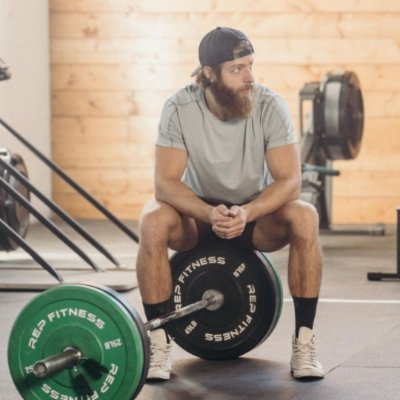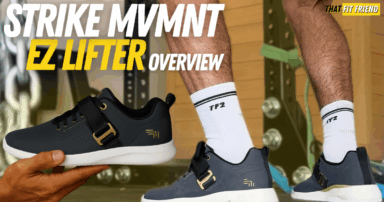One of my favorite things about reviewing countless workout shoes is breaking down the nuances that make each shoe unique. Some obsess over cars and their details, I obsess over workout shoes and their features.
I think my love for workout shoes and their nuances stems from my coaching and athletic background. As an athlete constantly trying to push towards new goals, I love learning how the anatomy of workout shoes can influence my performance.
Whether you’re new to workout shoes or you’re looking for a new pair to support your goals, it’s a good idea to understand some of the basics about a good gym shoe’s construction as this can be a make or break for your training style.
Author’s Note: This is not an article where I’m going to outline every construction feature in shoes simply. Instead, I’m going to cover eight things that, in my opinion, can be incredibly important for a shoe’s workout performance.
Anatomy of Workout Shoes
It’s important to note that the eight construction areas below will all vary slightly from shoe to shoe and this variance can influence a shoe’s performance for niche styles of training.
- Construction Details
- What to Look For

On that note, if you ever have questions about a shoe’s construction and how it will perform for your specific training style, always feel free to reach out. I also encourage you to check out my reviews on certain shoes as I dive into different use cases with each model.
1. Grippy Outsole
For workout shoes, a shoe’s outsole can be incredibly important for two key reasons. First, a good outsole will promote traction in the gym for different training styles. Second, well-built outsoles can prolong a shoe’s overall durability.
What Is It: The outsole is the term used to describe the material covering the shoe’s bottom. For example, if you’re wearing shoes at the moment, the outsole is the rubber material that protects your shoe’s midsole.
Why Does It Matter: In the context of workout shoes, an outsole can make or break performance in the gym. If you’re sliding around when training, then your outsole is failing you regarding its overall construction.
Two good examples here are slipping when doing skater strides during a HIIT workout and having the feet slip out when catching cleans and snatches in a CrossFit WOD.
Outside of promoting traction, an outsole can also prolong your shoe’s durability, which means you get more out of your investment. If you’re doing a lot of training on high-abrasion surfaces like concrete, you’ll want an outsole to protect your shoe’s midsole.

In addition, an outsole can also add a layer of protection when tackling more specific activities like rope climbs in CrossFit. This is why I often suggest steering clear of buying workout shoes that don’t utilize either full or close to full rubber outsole construction.
What to Look For: In a perfect world, your workout shoes should ideally utilize a full rubber outsole construction or an outsole close to fully covering the bottom of your shoes.
If you’re doing athletic-style training with jumping and multi-directional work, then this can be even more important. For CrossFit and tough cross-training sessions, additional outsole wraps over the toebox and midfoot can also be something to look for.
2. Stable and Responsive Midsole
The midsole is the material that separates the insole (inside of the shoes) from the outsole (bottom of the shoe). This is a supportive piece of material that varies in thickness depending on the shoe and its purpose.
What Is It: A shoe’s midsole is the foam layer that provides stability and responsiveness in a workout shoe. In most cases, workout shoes are built with medium—to high-density foams for their midsoles.
Why Does It Matter: The midsole used in a workout shoe can play a large role in the “feel” that you’ll get from the shoe when training in them.
Midsole feel can take many meanings but more often than not, most will look for a midsole feel that is more stable and dense or more plush and responsive or cushioned. The midsole in your workout shoe can be incredibly important depending on how you train.
If you’re planning to lift heavy objects in your shoes, you’ll want a denser and more stable midsole. A denser midsole compresses less when lifting and promotes a more balanced and stable feeling when training.
For example, if you’re wanting a workout shoe for CrossFit, then you’ll want a shoe with a denser midsole that can also be responsive. If you’re wanting a shoe for activities like HIIT, classes, and daily wear, then a plusher midsole can be a better call for supporting your comfort needs.
What to Look For: When deciding on your next workout shoe and considering the midsole that will be best for you, lead with how you train first. More often than not, a shoe built for a specific type of training will automatically utilize a midsole that will work well for that type of training.
This is why we have cross-training shoes that are built for things like CrossFit, lifting, and versatile training. All of these activities will require different demands from a shoe and most companies anticipate this with the materials they use in their shoe midsoles.
Additionally, this is also where reviews come into play as they can shed more light on how a midsole will “feel” for certain thresholds and types of training. If you ever have midsole-related questions about workout shoes, I’m always here to field your questions.
3. Durable Upper
A shoe’s upper can be important for a variety of reasons, but in the context of this article, I think there are three important players that relate to a shoe’s upper and these are comfort, durability, and breathability.
What Is It: The upper is the material of the shoes that encloses and protects your foot. It wraps up the midsole and extends over the entirety of the shoe and promotes the security you feel when wearing your shoes.
Why Does It Matter: In the context of workout shoes, the upper of your shoe can be important for durability, breathability, and the overall comfort you’ll feel when training. To expand on these, an upper with reinforced materials will help promote long-term durability.
For example, if you’re doing something like a cross-training or CrossFit workout where you’ll be dragging the toe during burpees or having a rope rub the top of your shoes, then you’ll want a shoe with reinforced materials versus something like a light knit.
If you’re training in hotter settings or outdoors, then a shoe’s upper should have some ventilation to help with your feet’s breathability. This can keep your feet cooler during your workouts and it can help limit how stinky your shoes get.
A shoe’s upper can also correlate to the comfort that you experience when wearing them. This is why it’s important to find shoes with upper volumes that align with your foot’s arch, thickness, and overall size.
What to Look For: If you’re doing workouts with a lot of contexts where you’ll be experiencing abrasion on your shoes, then you’ll want to find models that have reinforced constructions and heavier materials. Typically layered meshes and synthetic materials can be a good bet here.
If breathability is a major concern for you, then you’ll want to look at models that either feature decent ventilation through the forefoot and midfoot or find shoes with lighter and wispier materials like single-layer meshes and knits.
When it comes to comfort and making sure a shoe’s upper actually aligns with your foot anatomy, you’ll want to explore how spacious a shoe looks and you’ll want to read reviews on how others have described the sizing of the shoe.
A shoe’s upper volume can play just as much of a role in a shoe’s fit and comfort as a shoe’s overall width and length. Ideally, you’ll align all of these variables to find the best-fitting workout shoes for your individual feet.
4. Toe Box Width
The toe box in your workout shoe can be important to consider, especially if you have wider feet or constantly feel like your training shoes run a little too narrow.
What Is It: A shoe’s toe box is part of the shoe that makes up the base of the forefoot to the end of your shoe’s toe. I like to picture the toe box as a literal box that goes across the ball of your foot, then extends up the sides of the foot, and closes at the top of the foot.
Why Does It Matter: When we work out our feet take multiple shapes and forms. Every exercise whether we’re static or moving dynamically will then influence the shape our feet take.
If your shoe’s toe box runs a little too narrow for your foot anatomy, then you may be limiting some of your feet’s natural movement. This doesn’t necessarily mean that all progress all lost, but you might a wider toe box may be a little more comfortable.
On top of this, if your toes can move a little more freely, then you may find that your balance and stability also improve during certain exercises. This circles back to the importance of finding workout shoes that fit accordingly for your anatomical needs.
What to Look For: When it comes to exploring different toe boxes in workout shoes one of the best things you can do is to simply try different models and measure your feet.
Ideally, you’ll want to find shoes that have widths that align with your foot’s width. To record your foot’s width, measure the widest part of your forefoot, then use this size to cross-reference how your feet will fit into different companies’ shoes based on their sizing guide and others’ reviews on the shoe’s product page.
5. Flexibility
The flexibility of a workout will entail how well the shoe moves with your feet when you’re training. A great example here is doing a walking lunge. Does the shoe flex with the foot or feel clunky or stiff through the midfoot and toe box?
What Is It: Flexibility entails a shoe’s ability to articulate and move in different directions. A flexible workout shoe can bend in multiple directions which can be a good thing in certain contexts. Conversely, if you need more stability, then you’ll want a shoe with less flexibility.
Why Does It Matter: Shoe flexibility and its importance will ebb and flow based on your training style and preferences. For example, if you like a shoe that has a more minimalist feel to it regarding its articulation, then flexibility will be more important for you.
Oftentimes, lifters who are doing a lot of dynamic work on a weekly basis will prefer a shoe with a great degree of flexibility. This means the shoe will flex more when doing lunges, multi-directional work, jumps, and anything else that requires the feet to be dynamic.
If you’re someone who needs more stability in their shoes, then you’ll want to explore models with slightly thicker and denser midsoles as these can give you a more anchored and rigid feeling.
What to Look For: Flexibility will be a workout shoe component that will be seen in review content that is more demonstrative in nature. Typically, companies won’t discuss flexibility for their workout shoes.
If this is something you prioritize, then you’ll want to check out video reviews where the reviewer is showing themselves training in the shoes, or you’ll want to look for athletes who train in said shoes on social media. Doing a quick search of hashtags can usually be a good means of seeing the shoes in action.
6. Heel-to-Toe Drop
A shoe’s heel-to-toe drop can play a big role in how a shoe performs for you. Different heel-to-toe drops can change lifting mechanics so understanding your desired drop can be important for your training goals.
What Is It: A shoe’s heel-to-toe drop is the measurement of the height difference between the forefoot and the heel. Higher heel-to-toe drops will elevate the heels slightly more than shoes with lower or zero drops.
Why Does It Matter: Everyone will respond differently to various heel-to-toe drops. If you like training in flatter shoes or you naturally have a good level of mobility, then you may find that prefer workout shoes with heel-to-toe drops that sit at 4mm or lower.
For lifters and athletes like me that are a bit more lanky and like more “heel” with their workout shoes, then you’ll want to explore more with slightly heel-to-toe drops that sit at 6mm or above.
What to Look For: If you’re not sure about what heel-to-toe drop feels best for you, then you’ll want to test different shoes and do some trial-and-error assessments. Once you know what drop you prefer, most companies will list this spec on a shoe’s product page.
7. Stack Height
A shoe’s stack height isn’t necessarily at the forefront of things you should be considering when looking for a general workout shoe, but as you get more specific with your training you may find that your shoe’s stack height gets more important.
What Is It: A shoe’s stack height is the measurement that displays how much material separates your foot from the floor. Shoes with higher stack heights will be built with thicker midsoles and outsoles.
Why Does It Matter: Stack height can play a role in your lifting mechanics and influence how a shoe feels on the feet when training. In the context of lifting mechanics, if you want to be closer to the ground for things like deadlifts, then a lower stack height would be desired.
Conversely, if you want a shoe that has a plusher or more responsive feel then you may want to find a workout shoe with a mid to high stack height as these shoes will typically give you a little more cushion when training versus a more minimalist stack height shoe.
What to Look For: If you’ve decided that you have a specific stack height want with your workout shoes, then the easiest way to identify a shoe’s stack height is to simply look at pictures of the shoe compared to others or reach out to companies or reviewers who can give you a more concise measurement.
Frequently Asked Questions (FAQ)
Q:Why workout shoes?
Q:When to replace workout shoes?
Q:Can you run in workout shoes?
Wrapping Up
When finding the perfect pair of workout shoes for your needs that are a lot of factors that you can consider. These are seven that I would categorize as being important for lifters and athletes from all walks of life.
You should always try to find and pick workout shoes that not only fit your feet well but are designed to promote your performance for your style of training.
If you have additional questions about finding the perfect workout shoes for your needs, drop a comment below or reach out to me personally via Instagram (@jake_boly or @that_fit_friend).



























Add a Comment